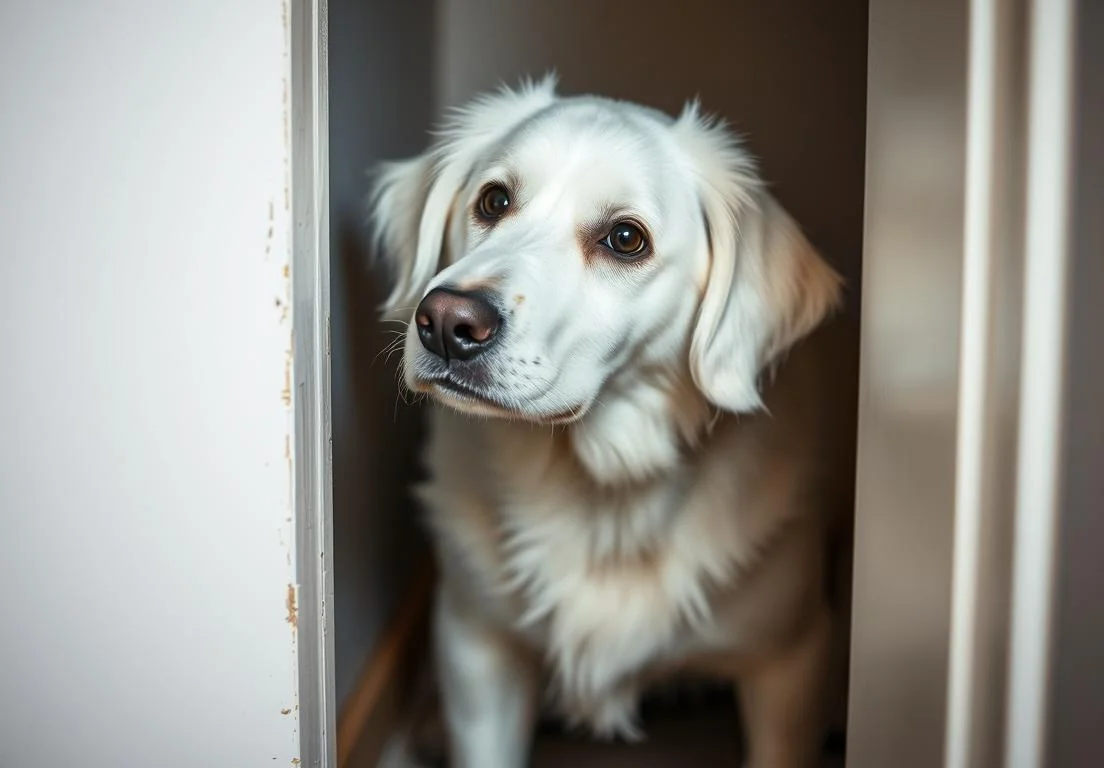Dogs have a knack for finding the coziest and safest spots—like your closet! If your pup has suddenly decided that hiding in the closet is their new favorite pastime, you might be wondering what’s going on.
There are various reasons why dogs seek refuge in tight spaces, ranging from stress to simply wanting a secure place to relax. Understanding your dog’s behavior can help you create a calmer environment for them. But there’s so much more to this than just a quick answer; stick around to uncover the hidden motivations and effective strategies to assist your furry friend.

Reasons for Hiding
Dogs often seek out closets and other small spaces when they’re overwhelmed. One of the most common reasons for this behavior is anxiety. Various triggers can cause anxiety, such as loud noises, unfamiliar visitors, or even changes in their daily routine. Your dog might find solace in a snug, enclosed space where they feel safer.
Fear is another significant factor. Dogs may hide during thunderstorms or fireworks, seeking refuge from perceived dangers. Even certain household situations—like vacuum cleaners or construction noise—can send them scampering for cover.
Instincts also play a role. In the wild, dogs instinctively seek out enclosed areas to protect themselves from predators. While your pup might not face wolves lurking in the closet, the instinct remains strong.
Stressors like new environments, unfamiliar smells, or the introduction of new pets or family members might also prompt your dog to retreat. Recognizing these reasons can help you address your dog’s underlying fears and create a more comforting environment.
Signs of Stress in Dogs
Hiding in a closet can be a clear sign your dog is feeling stressed, but there’s more to look for. Some subtle behaviors can indicate that your furry friend is struggling with stress:
- Pacing: If you notice your dog constantly moving back and forth, it can signal frustration or anxiety.
- Excessive Barking or Whining: Vocalizations can indicate distress, especially if they seem unusual for your dog.
- Changes in Eating Habits: A stressed dog may eat less or even refuse food altogether.
- Destructive Behavior: Chewing or digging can indicate anxiety; some dogs redirect their nervous energy onto household items.
Being observant can make a difference in understanding your dog’s behavior and addressing their needs. Consider keeping a diary of their behaviors, which can help identify stress patterns that may need attention or action.
Environmental Factors
Changes in your home can significantly impact your dog’s behavior. Loud noises—like construction work, fireworks, or even a vacuum cleaner—can scare your dog, prompting them to seek refuge in a cozy spot like a closet. Similarly, new furniture or layouts can be disorienting. Dogs thrive in familiar environments, so any upheaval might cause anxiety.
Also consider household changes such as new pets or people moving in. These shifts create stress for dogs, nudging them towards solitude when they need a break. If there’s tension in the home, whether through arguments or high-stress situations, dogs can pick up on those vibes too. Ensure your environment is calm and predictable, giving your pup a sense of security amidst life’s changes.
How to Encourage Confidence
Creating a confident dog requires intentional effort and patience. Start by establishing a safe space where your dog feels sheltered but not isolated. This could be a cozy corner with their bed and favorite toys. Make this spot inviting by spending quality time there and encouraging your dog to join.
Positive reinforcement is vital. When your dog shows confidence—like exploring or engaging with you—reward them with treats or praise. Gradually expose them to new experiences at a comfortable pace. This builds their resilience without overwhelming them.
Incorporating structured routines can also help. Dogs find comfort in predictability, so regular feeding, walking, and playtime can foster a stronger sense of stability.
Consider engaging your dog in social playdates with other friendly and well-behaved dogs. These interactions help them learn to navigate various situations and build social skills.
Lastly, if your dog frequently retreats to hide, consult a professional trainer or animal behaviorist. They can provide tailored guidance to address your pup’s specific needs and boost their confidence effectively.
Creating a Safe Space
Dogs often seek out cozy spots, like a closet, when they feel anxious. To encourage your furry friend to find comfort outside of these hidden nooks, it’s crucial to create a designated safe area for them. Start by choosing a quiet place in your home, away from the hustle and bustle.
Consider setting up a comfortable bed or blanket that smells like you. Adding familiar toys can also ease their worries. Make sure the area is cozy and inviting; think about incorporating soft lighting and perhaps even a calming sound machine.
Implementing a “safe zone” can give your dog a sense of security. Gradually introduce them to this new space with treats and positive reinforcement. Sit with them for a few minutes to reinforce that it’s a good place to be. It’s not just about creating a cozy spot—building positive associations with this new area will help them feel it’s a safer option than hiding in the closet.
Play and Interaction
Regular play and interaction are essential in keeping your pup mentally and emotionally balanced. Consistent engagements not only strengthen your bond but also reduce anxiety that might drive them to seek refuge in hidden spots. It’s all about creating a routine.
Incorporate daily walks, interactive toys, or even puzzle games that challenge them. Activities that stimulate both their body and mind can divert their attention from stressful triggers. It’s vital to gauge what your dog enjoys—fetch, tug-of-war, or scent games.
Perhaps more importantly, consider the impact of your presence and attention. Dogs thrive on social interaction, so set aside dedicated time just for them—whether it’s training, playing, or simply relaxing together. This routine can build their confidence and reduce the instinct to hide. Keeping your dog engaged and at ease is key to easing their desire to retreat to the closet, giving them a sense of security and comfort within your presence.
Health Considerations
A dog hiding in the closet might be more than just a quirk; it could signal underlying health issues. If this behavior is new or has intensified, keep an eye out for other signs. Your pup might be feeling unwell due to pain, anxiety, or recent changes at home. It’s time to consider a vet visit if you notice:
- Unusual vocalizations like whimpering or barking
- Changes in eating or drinking habits
- Increased agitation or nervousness
- Specific body language such as trembling or trying to escape
Conditions like arthritis, skin allergies, or even stomach issues could cause discomfort that leads a dog to seek solitude. If the behavior persists alongside any of these symptoms, consulting a vet can help identify the cause and ensure your dog gets the care they need.
Trivia and Fun Facts
Dogs are fascinating creatures, and their instinctual behaviors run deep. Did you know that a dog’s instinct to hide comes from their wolf ancestry? Wolves often seek shelter or cover to protect themselves from predators and environmental threats.
Here are a couple of interesting tidbits about dogs and their hiding habits:
- Safety: For many dogs, finding a cozy spot like a closet is a natural instinct to feel safe and secure, especially during storms or fireworks.
- Privacy: Some breeds, particularly more independent ones, might hide when they need a breather from all the hustle and bustle of family life.
Understanding these behaviors can enhance your connection with your furry friend. Each dog is unique, so learning about what makes yours tick might just lead to deeper trust and companionship.
Expert Tips
Understanding why dogs hide in closets can help you support your furry friend better. While it’s natural for dogs to seek out caves or cozy spots, it’s vital to recognize the underlying reasons for this behavior.
Stress and Anxiety : Many dogs retreat to small spaces when they’re feeling anxious. Loud noises, such as thunderstorms or fireworks, can trigger this instinct. A calming environment might help them feel safer. Consider creating a safe space with their favorite blanket and toys.
Illness or Discomfort : If a dog suddenly starts hiding, it might signal that something’s off health-wise. Pain can cause them to withdraw, so it’s a good idea to keep an eye out for other symptoms and consult your vet if needed.
Natural Instincts : Dogs have an innate desire to find secure and quiet spots. Providing options for cozy areas around the house can channel this instinct positively. Dog beds in quiet corners or covered crates can offer a comfortable hideout.
Boredom : Sometimes, it’s just boredom that drives them to seek refuge. Making sure your pup gets adequate mental stimulation through interactive toys or training sessions can keep them engaged and reduce the hiding behavior.
Socialization Issues : Some pups may feel overwhelmed in social settings. If this is the case, gradually introducing them to new environments and people can help boost their confidence.
Different dogs will have varying preferences for how they want to retreat. For some, it’s a closet; for others, it could be under a table or bed. If you notice your dog’s hiding has escalated, or if it’s coupled with unwanted behaviors, it might be time to seek advice from a professional dog trainer or a behaviorist.
Increasing your awareness of these factors can create a more relaxed atmosphere for both you and your dog. Establishing routines and recognizing their needs will foster a deeper bond and a happier home life.
Alex, a passionate animal lover, has experience in training and understanding animal behavior. As a proud pet parent to two dogs and three cats, he founded AnimalReport.net to share insights from animal experts and expand his knowledge of the animal kingdom.



